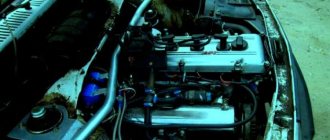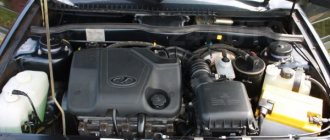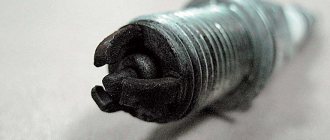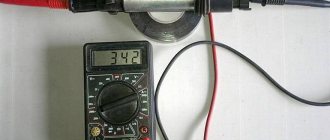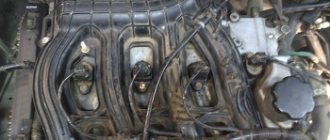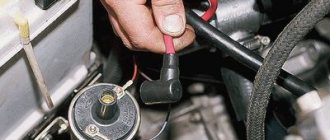Despite the huge amount of criticism against the Lada Priora, this is one of the most popular cars that have come out of the AvtoVAZ assembly line in recent years. The Priora is equipped with a fairly successful engine with good dynamics, and the interior is very comfortable. And the maximum trim levels offer useful options. But at the same time, from time to time the car brings minor problems to its owners. One of the most popular malfunctions is that the Priora engine (16 valves) is tripping. The reasons for this phenomenon are quite unpleasant. And besides, the motor eventually overheats.
When the driver starts his car in the morning, the engine does not run smoothly as before, but intermittently. At this time, dull sounds are heard from the exhaust pipe. At the same time, a persistent and strong smell of unburned fuel is felt. Vibrations are constantly increasing, and this is fraught with cracks in the pillows. This is how the engine runs when cold.
Trouble the engine: why is it dangerous?
This is a rather critical phenomenon, especially if the unit begins to vibrate during acceleration.
This behavior of the engine is especially dangerous when the driver decides to overtake, but there are cars in the oncoming lane. In the process, while the motor is running, the engine power is significantly reduced. The compression ratio decreases - there may not be enough dynamics to successfully complete the maneuver.
Considering that the Lada Priora has been manufactured since 2007, there are often instances where the engine knocks like on an old car 20 years ago. This is an engine running on three cylinders. It may have the latest firmware, but if the engine of a Lada Priora car is running rough and the check light is on, then such a car will not have much life left.
Signs of engine tripping
If the Priora’s engine starts to stall, it’s hard not to notice; the car will show the following signs of a malfunction:
- Loss of vehicle traction;
- Gases will come out of the exhaust pipe unevenly, and small pops will be heard;
- On the dashboard, the “CheckEngine” lamp will initially flash, and then remain on. The engine control unit will record an error about misfire in a certain cylinder.
- The engine will take longer to start or you will need to press the gas pedal to start the engine;
If your car shows such signs of malfunction, then most likely one of the cylinders in the car is not working.
Supply system
If the Priora engine (16 valves) is tripping, the reasons may be trivial. When there is no flash in the cylinder, perhaps there is simply no fuel there. If it has a normal compression ratio, it is worth diagnosing the power system. You should pay maximum attention to the air filter and the pipe. It is necessary to make sure that the clamps are securely tightened, whether the purifier body itself is intact, and whether there is any air leakage from the outside. Also pay attention to the tubes. They must be tightly secured to the throttle assembly. Fuel leaks, cracks, and broken plastic may indicate that some parts are faulty.
Checking the air filter
If the spark plugs and high-voltage wires appear to be in full working order, and the engine still runs, you should check the air filter. Sometimes this element may simply become clogged, as a result of which less air will flow into the engine, which will cause the analyzed breakdown. According to experts, there is no point in cleaning the air filter from contaminants, because the cost of a new element is quite acceptable, so it is better to simply replace the filter that has become unusable with a new one.
Nozzle failures, clogging
When the Priora engine (16 valves) fails, the reasons often lie in the injector.
It may be faulty or simply blocked. Beginners and those who like to pour various injector cleaning fluids into the tank often encounter this problem. All this leads to the fact that the dirt first peels off in the tank, then in the fuel line. And eventually it will end up in the injectors, where it will happily get stuck.
The engine stalls when hot: causes and common faults
Let's start with the main features. Often, a cold engine starts quite normally, but then begins to stall after partial warming up or completely reaching operating temperatures. In this case, tripping can occur both at idle and under load (while driving).
You should start by checking the control system (ECM) and the engine power system. It is recommended to immediately carry out computer diagnostics and check the condition of the injector and injectors.
In any case, incorrect readings or malfunctions of sensors (lambda probe, temperature sensor, mass air flow sensor, etc.) and actuators can cause a hot engine to fail. Based on incorrect readings, the ECU may well over-enrich the working fuel-air mixture and flood the spark plugs.
Next you need to move on to the spark plugs. At the initial stage, you should remove the spark plug high-voltage wires and unscrew the spark plugs from the BC. Next, a visual inspection of their contacts and insulators is carried out. Normally, candles should be dry, grayish in color, without a heavy layer of soot.
If the spark plug is wet and/or oily, then it is quite obvious that too much engine oil is entering the combustion chamber or the fuel is not being burned in the cylinder. In any case, a wet spark plug does not allow the cylinder to operate normally. Let us add that often both causes are often present simultaneously or are a consequence of each other.
If all the spark plugs are wet, you should check the oil level in the internal combustion engine. When the level is elevated (often as a result of overflow), the oil pressure in the lubrication system after the engine warms up exceeds the norm, excess lubricant penetrates the combustion chamber and contaminates the spark plugs. The result is a weak spark.
You also need to check the crankcase ventilation system. For example, the breather hose may become kinked, contamination may occur, etc. The main thing is that problems with this system also lead to pressure rising and excess oil entering the cylinders. If the hot vibration disappears after pumping out excess oil and cleaning the crankcase ventilation system, we can talk about a successful solution to the problem.
If this does not help, the spark plugs themselves will require increased attention. It is likely that even if the spark plugs have recently been changed, they will turn out to be incorrectly selected for the engine in terms of heat rating and will be “cold”; also, the spark plugs may simply fail or the product will be defective. To check, you need a kit that is known to be working (it is better if the spark plugs were removed from another car). If the engine does not start in these sections after warming up, then the spark plugs need to be replaced.
If it turns out that the dry spark plug in the cylinder has become wet, then it is worth checking the high-voltage ignition wire of a particular cylinder. The wire needs to be replaced with a working one. Also note that the problem may not be in the wires. For example, on carburetor internal combustion engines, a common cause of ignition problems is the distributor (ignition distributor).
On injection engines, failures can result from breakdowns of the ignition coils. In the case of a distributor, the device must be disassembled, dried, cleaned the contacts and made the necessary adjustments. If we are talking about an engine with an injector, you can swap the ignition coils and wires. This method allows you to quickly identify a faulty coil.
Poor quality fuel
This is one of the possible reasons why the engine stalls at idle or while driving.
To return to normal operation, you can try changing the gas station. This usually helps clear up a lot of misunderstandings. It is better to fill the 16-valve Priora engine with good 95-octane gasoline. It's not worth pouring something with a higher octane number. This will only lead to overheating. You can also try replacing the air and fuel filters. Sometimes this solves the problem.
Content
- Reason 1 – spark plugs
- Reason 2 - ignition coils
- Reason 3 – injectors or throttle body
- Reason 4 – fuel filter
- Reason 5 – mass air flow sensor or ECU firmware
- What to do to prevent the Priora from jerking
“Help, my Priora car is shaking while driving. What to do? What could be the problem?" – a car enthusiast wrote on one of the forums. This problem often occurs in domestic cars, and there may be several reasons for its occurrence. Let's figure out why the Priora twitches, how to solve the problem and how much it costs.
Ignition system
An experienced car enthusiast who is faced with an engine running on three cylinders immediately begins to diagnose the spark plugs. The Lada Priora must cool well, otherwise there is a risk of getting burned when unscrewing it. If after a few seconds you turn off the ignition and check the spark plugs, one of them will be wet with gasoline. It is also recommended to separately check each part for the presence of a spark.
In case of malfunction, the problem is solved by replacing the spark plug. Sometimes it is enough to press down a potentially faulty one with a cap and the machine will resume normal operation. In general, the ignition system in this car is the most problematic part. If the Priora engine (16 valves) is malfunctioning, you can look for the reasons for a very long time, and diagnostics will not yield anything, even if it is done correctly. And only by replacing all elements can a positive result be achieved.
Inspection of high voltage wire
Often, the Priora stalls when accelerating due to a malfunction of the ignition system. This is especially true for the condition of the high-voltage wire leading to the spark plug. To inspect it, you will need to remove the tip attached to the spark plug. The structure of a high-voltage wire is as follows: the winding contains the central core of the wire. The tip, which is put on the candle, has a persistent metal penny. The main purpose of this element is to transmit current to the spark plug.
The core of the high-voltage wire should fit as tightly as possible to the “penny” of the steel tip placed on the spark plug. Due to aging, contact between this element and the wire may be lost due to oxidation of the metal. As a result, tripling occurs. The oxidation of the contact is checked as follows: with the second probe of the multimeter, you should touch the central core of the high-voltage wire; if the core of the high-voltage wire burns out along its entire length, then it is possible to identify such a section using a special multimeter tip.
The wire is pierced until the affected area is identified every 5-10 mm. If such a section is detected, it is cut off if the length of the high-voltage wire allows it. Otherwise, it needs to be replaced.
Diagnostics of spark plugs by plaque
When the engine starts cold or hot, you can check the carbon deposits on the spark plugs. If the coating is white, then this indicates a lean mixture and overheating of the engine. A black tint indicates a rich mixture. In both the first and second cases there are problems with the operation of the electronics. This is either installing new firmware, or replacing the ECU. A normal candle has a brick color. By the way, the engine may stall at idle if the part is damp. This also significantly increases the warm-up time. In addition to the spark plugs, the ignition coil may also be acting up. Priora (8 valves) is equipped with distributor ignition. Overheating of the coil is often observed. You can restore the operation of the motor by simply replacing the element.
Troubles when pressing the gas pedal sharply
When the Priora engine stalls when the throttle is opened sharply, this indicates a breakdown of the insulation of the individual ignition coils. The IKZ has rubber seals that isolate the cap of the coil and spark plugs, thereby preserving the spark from breakdown; when this cap wears out or is damaged, the spark can go to the engine body, thus, when the gas pedal is pressed sharply, it will pierce the body, which is why the internal combustion engine will triple.
Checking the ignition coil
There is simply no special method by which you can check the operation of parts. The instructions for the car indicate one of the methods for self-diagnosis. So, with the ignition turned off, check whether the ignition coil (Priora is no exception) is firmly attached to the engine.
Then they look at the reliability of electrical connections in the low-voltage circuit. If everything is in order, then check for a spark. To do this, the ignition coil is removed. A test plug is inserted into the tip and pressed against a metal part of the engine. Next, turn the starter. If there is no spark, replace the coil. If there is a flash, but the engine does not start, change the spark plug.
see also
Comments 12
it was about the same thing, the oxygen sensor died! just unplug the plug and check if it works or not. but the check engine light comes on!
This happened to me: the coil died, the next day I replaced it with a new one, but the black smoke due to overflow never stopped coming out of the exhaust pipe. I unscrewed the spark plugs, they were covered in black soot, replaced them with new ones, it didn’t help. Then I unscrewed the oxygen sensor, and it was also very heavily carbonated. After replacing the DC everything became normal.
Checking the ignition coil - Disconnect the ground wire from the battery. — Remove the cover from the ignition coil and disconnect the wire from it. — If the plug comes out of the coil, replace the coil. — Check the coil for cracks, replace if necessary. — Measure the resistance of the primary winding of the coil by connecting an ohmmeter to the contacts. — Measure the resistance of the secondary winding of the coil by connecting an ohmmeter to the contacts. — Connect the wires to the ignition coil. — Install the coil cover. — Connect the ground wire to the battery. If you are going to replace the ignition coil, do not install a regular coil controlled by the ignition chopper under any circumstances, otherwise the control computer will be damaged.
Many Lada Priora engine owners have experienced the engine starting to misfire. What are the reasons for this effect? Let's consider the main ones, as well as methods for troubleshooting.
Troubles when cold - Community "Lada Priora (Lada Priora Club)" on DRIVE2
Hi all! I recently wrote a post about a stuck pump, and so, the valves still had to be changed (( We changed all 16 valves, oil seals, and at the same time the injectors, because two had a burst housing, and the mileage was 111 thousand, the car definitely started to drive more cheerfully .But today I start it and it starts up. And I held it at 2-3 thousand revolutions, it works more or less, I release the pedal - it starts and the check blinks, and then goes out. As a result, I kept it at 2 thousand until 90 degrees, the work leveled off, I released the pedal - that's it normal. And all evening I drove everything was fine. I started it when it was hot, no problems. Right now I decided - let me check. The engine has cooled down. I start it - it troits. First - I determine the cylinder - the second. I change the coils, remove the terminal - it still troits 2. I cleaned the throttle, no changes. I just recently changed the spark plugs. Unfortunately, I don’t have a scanner at hand, but even without it it’s clear that there are misfires in cylinder 2, but here’s why? In theory, if the valves weren’t seated well, it would be misfiring all the time, right? By the way, the hydraulics are rattling alone, have you heard that they can also cause triple noise?
Danger of malfunction
When the power plant starts to stall during acceleration, it is very unsafe. In this case, power is reduced, the overall level of compression and dynamics of the car is sometimes simply not enough to complete the maneuver. Therefore, immediate repair is indicated here.
So, in addition to a decrease in twitching, power, lack of acceleration and other undesirable sensations, an engine operating without one cylinder can quickly become unusable. And the reason is very banal: the inactive cylinder still receives fuel that does not burn. Undoubtedly, the fuel is thrown back through the valve, but a certain part of it settles on the walls of the car cylinder. Because the rings are not able to perfectly clean the cylinder walls, some of the fuel enters the crankcase, mixing with the oil. The composition of gasoline and oil is considered insufficient for high-quality lubrication, therefore, the power unit overheats.
At the same time, grooves appear on the cylinders and the piston group is disrupted. Due to severe wear, the compression ratio decreases, and the car owner will have to overhaul the engine. Taking into account the fact that the production of the Lada Priora began in 2007, it is not uncommon to see cars with a knocking sound in the engine, reminiscent of old cars. The reasons are the same - driving on an engine that revs up during acceleration. Even if the car has new firmware, if the cylinder is switched off regularly, the drive will not last long. Under no circumstances should you drive for a long time if the engine starts to stall. Try to move slowly while keeping an eye on the temperature gauge. In addition, on the eve of the trip it is worth checking the oil level.
Taking into account the fact that there are many factors for unstable engine operation in a Priora, it is advisable to contact a trusted service station.
VAZ 2110 troits engine
Engine problems, even episodic ones, always need to be addressed immediately. For example, it happens that at times the engine of a VAZ 2110 stalls, and many do not pay attention to this, continuing to operate the car as if nothing had happened. But this is the wrong attitude to this problem. Let’s look at the causes of this symptom and consider ways to quickly eliminate them.
When is it time to check the engine?
The engine should always run like a clock, that is, smoothly and without jerking, failures, or jumps.
At idle speed it is easy to notice that the engine is unstable. When such suspicions creep in, it is better to raise the hood and listen to the beats in all cylinders. “Troit” means one or two cylinders are inactive, since there are no conditions necessary to ensure the processes in their combustion chambers. As a result, the actual power of the power unit drops noticeably and gasoline consumption increases. There is also a tendency to stall, for example at intersections, at traffic lights or while warming up. At the same time, when the engine of a VAZ 2110 fails, the reasons for such a malfunction can be different. You can find out which cylinder has problems in one simple and long-known way. With the engine running, you need to remove the high-voltage wire from each spark plug one by one. If the cylinder was working properly before, then when it is turned off there will be a noticeable dip and a drop in speed (look at the tachometer scale). If there are no changes after removing the wire from the spark plug, we can safely assume that the problem is precisely in this cylinder - it was not working before the shutdown.
Causes of unstable motor operation
Here is an approximate and incomplete list of reasons for the “ten” engine tripping:
- spark plug malfunction, getting wet;
- breakdown of a high-voltage wire;
- extremely low quality gasoline;
- air leaks in the vacuum brake booster system;
- loss of tightness in the area of the intake manifold;
- need for valve adjustment;
- valve or piston burnout;
- development of valve levers;
- breakage of piston rings;
- cylinder head gasket breakdown;
- deterioration or unsuitability of valve stem seals.
We will not dwell on all the points one by one, but it makes sense to note some methods for quickly identifying easily repairable breakdowns. So, for example, a non-working candle becomes an elementary problem. The same applies to broken armored wires. The easiest way to identify a malfunction is to replace each of these elements one by one with a known working one. It is also sometimes possible to notice sparking in the dark, which will indicate to you a damaged high-voltage wire.
There can be plenty of discussion about problems with valves, because such a “disease” is very typical for VAZ engines. First of all, we must not forget that every 10-20 thousand km the valves must be adjusted so that they are completely closed or opened during operation. But infrequent cases of valve and even piston burnout require accurate measurements of compression in the cylinders and subsequent opening of the power unit. In this case, the wear and tear of the piston rings is determined by pouring a small amount of engine oil into the cylinder - if the compression has increased, then the problem is most likely in the rings.


